by David Midgley
Love them or hate them, freshwater snails are common in the aquarium hobby. This guide gives a brief outline of the commonly encountered species in Australia.
Malaysian trumpet snail
Melanoides tuberculatus
In brief:
* Origin: Cosmopolitan (Asia & Africa)
* Method of introduction: accidental, with gravel or plants.
* Nuisance potential: High. Particularly if overfeeding, populations can increase at very fast rates
* Usefulness: Doesn't eat most plants, eats excess food, turns gravel
* Control: Botias
Melanoides tuberculatus is a cosmopolitan snail species that occurs throughout Asia and Africa. They are easily recognised by their elongate, conical shell which is generally brown with some darker spots. These are livebearing snails which can produce significant numbers of young if sufficient food is available. Generally nocturnal, they bury themselves in the gravel during the day. Aquarists seem divided on the value of this invertebrate; those who dislike them report that they breed too quickly, clog filters and damage impellors. Those who like them extoll their abilities to clean up excessive fish food (thus maintaining better water quality), their seeming disdain for most aquarium plants and their habit of “turning the gravel” in aquariums, much like earthworms do in a gardenbed.
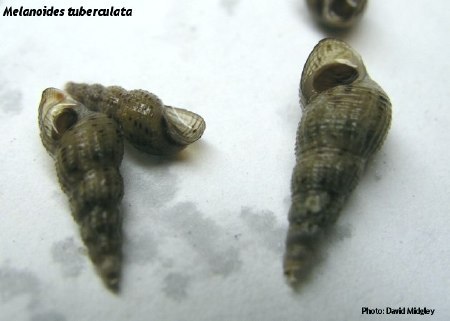
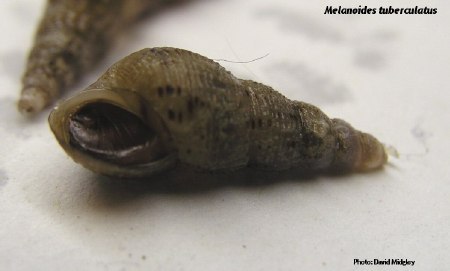
I’ve had this snail in a number of my aquariums for some time. I’ve not found their population growth uncontrollable, and when population explosions do occur it’s a useful indictor of overfeeding. Control of these snails is generally straightforward and is best acheived by more conservative feeding. Complete removal of this species from aquaria is difficult, however, most loaches (Botia sp.) will readily consume this species and are a good method for keeping snail numbers down or removing them completely. Some african cichlids (eg: Chilotilapia rhoadesii) will also eat these snails.
Small ramshorn snail
Planorbis? or Helisoma? sp.
In brief:
* Method of introduction: accidental, with gravel or plants.
* Nuisance potential: High. Particularly if overfeeding, populations can increase at very fast rates. Eats some plant material, suspected egg eaters.
* Usefulness: eats excess food
* Control: Botias
I have this small species (max. adult size < 5 mm) of ramshorn snails in a number of my tanks. I am yet to identify the species, and do not know how they arrived. Presumably as contaminants on plants or gravel. The species is active during the day and can be seen grazing on algal lawns on glass. I also suspect this species of being a egg-eater, as it has slowed the rates of reproduction in tanks with co-habiting lamprologine cichlids. The species is an egg layer and lays a group of eggs in a patch covered by a mucousy, gelatinous substance. This species (or something morphologically similar) has been reported by other aquarists
http://www.fishpondinfo.com/snail2.htm.

Columbian ramshorn snail
Planorbis? or Marisa? sp.
In brief:
* Method of introduction: less frequently accidental
* Nuisance potential: Low, the species is large and has relatively small (by snail terms) clutches.
* Usefulness: eats excess food
* Control: Botias
I have this larger species (max. adult size > 3cm) of ramshorn snails in just one of my tanks. Like the smaller species above, I am yet to identify the species, though they have been present in the tank for sometime. The species is active during the day and can be seen grazing on algal lawns on glass, though they seem more interested in excess food and readily detach and “sail” to the source when it’s available. The tank they are inhabiting also contains a colony of Pseudotropheus sp. “Msobo”, and the two animals seem to largely ignore each other. The snails certainly dont pose a problem in terms of mouth breeding as has been reported for some smaller species.. The species is an egg layer and lays a group of eggs in a patch covered by a mucousy, gelatinous substance.
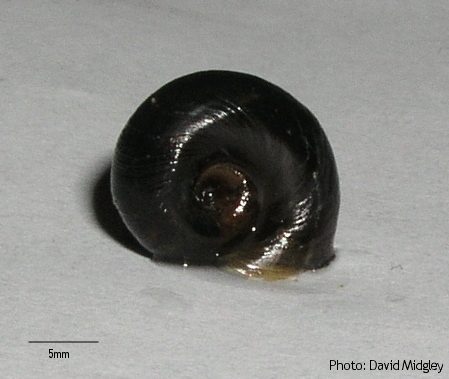
Columbian ramshorn snails come in a variety of colours. Not sure if the colouration is a genetic trait (or limited to one species), but all my ramshorns are inky black.
Apple or mystery snail
Pomacea bridgesii sp.
In brief:
* Method of introduction: generally introduced
* Nuisance potential: Low, the species is large and lays its eggs out of the water.
* Usefulness: eats excess food, novelty
* Control: Manual removal
For more information see the definitive Apple Snail (Ampullariidae) website [url]http://www.applesnail.net/[/ur]
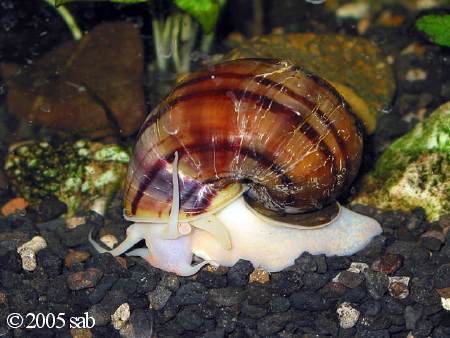
Dark coloured form
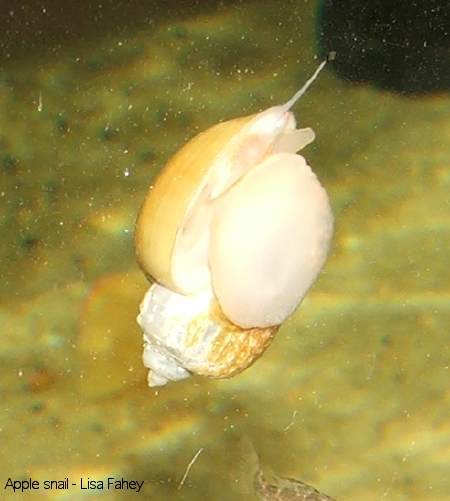
Gold coloured form




 This topic is locked
This topic is locked



